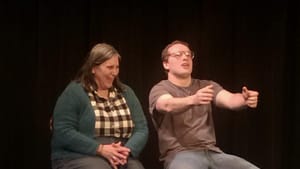Stay in the Loop
BSR publishes on a weekly schedule, with an email newsletter every Wednesday and Thursday morning. There’s no paywall, and subscribing is always free.
The power of 'Yes, and . . . '
Philly Improv Theater

A few hours ago, I was sitting in the cockpit of a very small airplane being flown by someone with a very cavalier attitude toward both common sense and the laws of physics — and, more distressingly, toward how they might impact my personal safety. I was, naturally, completely (and very vocally) freaking out.
Actually, though, there was a sense of calm at the core of my freakout: The pilot was Adam Steiger, a man I’ve learned to trust completely; the cockpit was a pair of bentwood chairs on an otherwise empty stage; and before we could crash, a fellow troupe member “swiped” (ended) the scene by running across the stage.
It was the graduation show for Improv 101, Intro to Improvised Scenework, at Philly Improv Theater (PHIT) — the culmination of a mere eight weeks of classes taught by Corin Wells that turned 15 disparate strangers from a very wide variety of backgrounds into a cohesive group of performers who were prepared to get on stage — in front of an audience! — and do two sets, or montages, of themed scenes that, yes, we really were making up on the spot.
It started innocently enough last fall. I was working at a temporary copy-editing job and had become friendly with a full-time employee there. Although copy-editing is satisfying — and actually a fair amount of fun — if you have the temperament for it (which Gwyn and I both, alas, do), tinkering with the number- and tense-agreement of verbs and the correct placement of semicolons isn’t all that fulfilling. “I need to do something creative,” Gwyn groused one day, “Something fun. I’m thinking of taking an improv class.”
“You definitely should,” said I, always willing to persuade someone else to do something they’re considering, especially if it requires no actual involvement on my part. “That would be a lot of fun.” It didn’t take long, though, to realize that the reason I was so enthusiastic about Gwyn taking improv was that I wanted to — and even less time to realize that PHIT is conveniently based in Center City and that they offer free introductory workshops. Kismet.
We went, and five minutes after walking out of the workshop we’d talked each other into signing up for the full eight-week course. Now, a few short months after that first idle conversation, she and I — and our classmates — are all denizens of the Philly improv subculture, centered on (but not limited to) classes, practices, shows, and jam sessions at PHIT, plus a meal before or drinks after any of the above. It’s quite a change from my usual pursuits of working, knitting, working, binge-watching TV shows on Netflix, working, and keeping an eye on the visitors at the cluster of bird-feeders outside my office window. Oh, and working.
Pure play
What makes improv so addictive? It’s play — pure play, of a sort I haven’t experienced since I was a kid. The first lesson you learn in improv is to let go of your fear of looking like an idiot. It turns out there’s an immense freedom when you just throw yourself into an activity — any activity — without really caring what other people think. There’s no “cool” in improv. How liberating!
The second lesson you learn is to support each other unreservedly (which, by the way, definitely makes it a whole lot easier to throw yourself into whatever the activity is). “Yes, and . . .” is the improv mantra: Rather than disagreeing or finding fault with what your scene partner just said or did, you take it, agree with it, and build on it. That’s a tough lesson and one I’m still struggling with. It’s a little sobering to realize how often my first reaction to a suggestion (in improv or in life) is to critique it, if not outright reject it. “Yes, and . . .” does not come naturally. (I’m currently working with Dan Rottenberg and a consultant on long-range planning for BSR — it turns out that that is a good project to take a “yes, and . . .” attitude toward.)
In improv, newbies quickly learn the paired basics of “go ahead and make a fool of yourself, and your partner will support you.” One of the more interesting side effects of this is that there is no favoritism or cliquishness (unlike, say, junior high — or many an adult office). Since you know your partner will support you, in a very real sense it doesn’t matter who your partner is. Thus, when you’re running scenes in a practice and the teacher says “two people up,” two random people get up and you see what happens — you don’t hang back till someone you like gets up, and you don’t try to manipulate the count so that you’re paired with the most experienced or funniest partner.
So improv is playful, supportive, and egalitarian. It’s also collaborative. An improv set is the mutual creation of a group of people who all add their own touches to a piece that none could come up with individually. Improv thus involves a kind of teamwork utterly unlike anything else I experience in the rest of my life. In a business environment, even when there’s genuine camaraderie and mutual support on a working team, there’s also a division of tasks, to say nothing of a hierarchy. Not in improv — there’s no leader, no boss, no director. All responsibility for creating and shaping the performance is shared: Who’s up next? Whoever’s ready to go. Who will start the scene? The first person to start talking or gesturing. Who will end it? The not-in-the-scene member of the team who senses that it’s time to move on and runs across the stage to swipe the scene. The responsibilities are shared — and so are the joys of creation.
So, Gwyn — you needed to do something creative and fun? Me too. Thanks for talking me into it.

Corin Wells’s Improv 101 class, Winter Term 2014, Philly Improv Theater. Back row: Maura Pennington, Adam Steiger, Andy Ramish, Judy Weightman, Ben Zheng, Shawn Hagan, Ryan Birchmeier. Front row: Marissa Falyn, Shannon Patterson, Athena Kazantzis, Gwyneth MacRae, Dana Weber, Matt Merin. Absent: Joe Knapp, Mareen David. Photo by Corin Wells, courtesy of Dana Weber.
What, When, Where
Philly Improv Theater (PHIT), at the Adrienne Theater, 2030 Sansom Street, Philadelphia, PA, 19103. Performances at the Second Stage (2nd floor); offices in Suite 300. 267-233-1556 or phillyimprovtheater.com.
Sign up for our newsletter
All of the week's new articles, all in one place. Sign up for the free weekly BSR newsletters, and don't miss a conversation.

 Judy Weightman
Judy Weightman